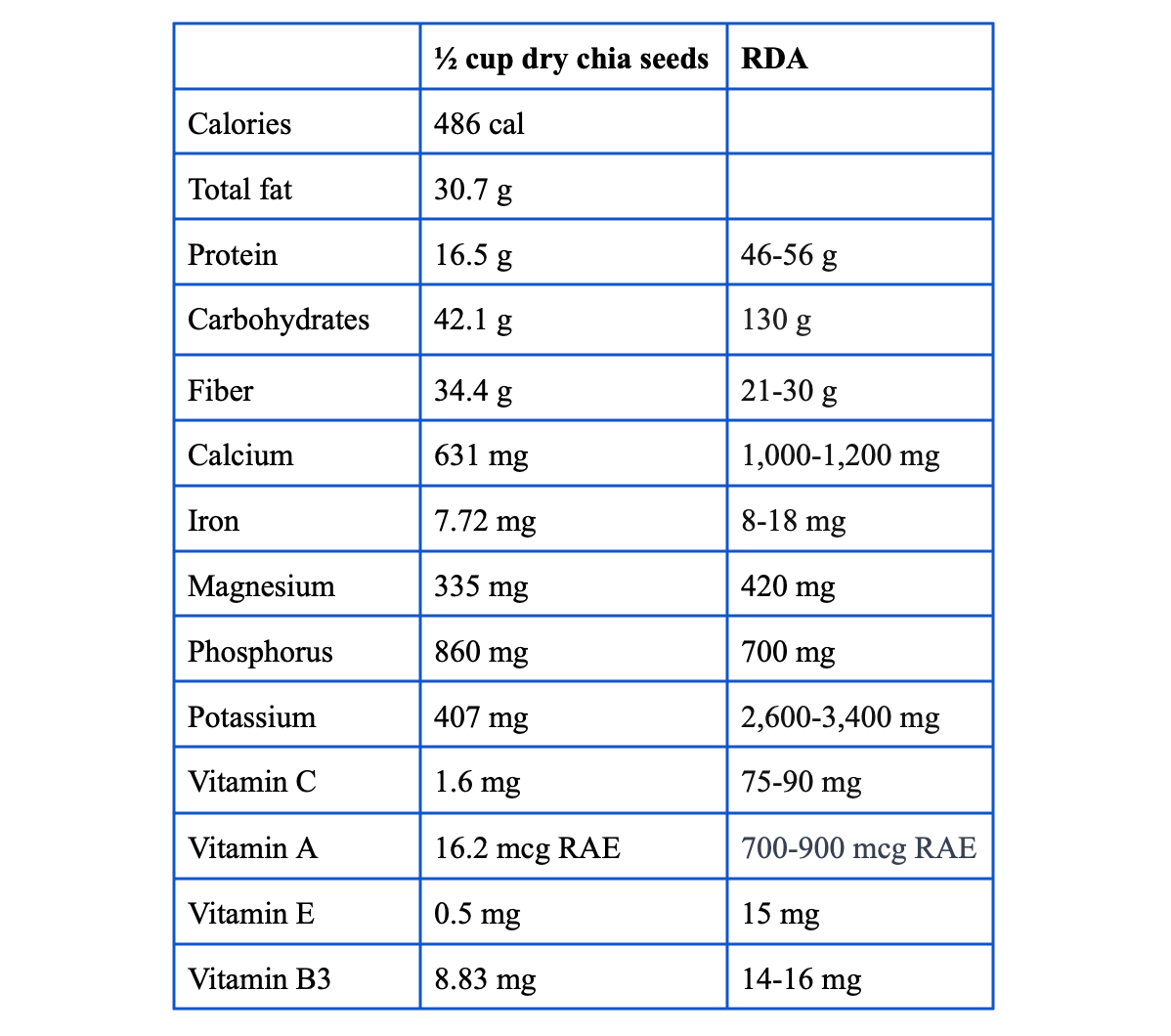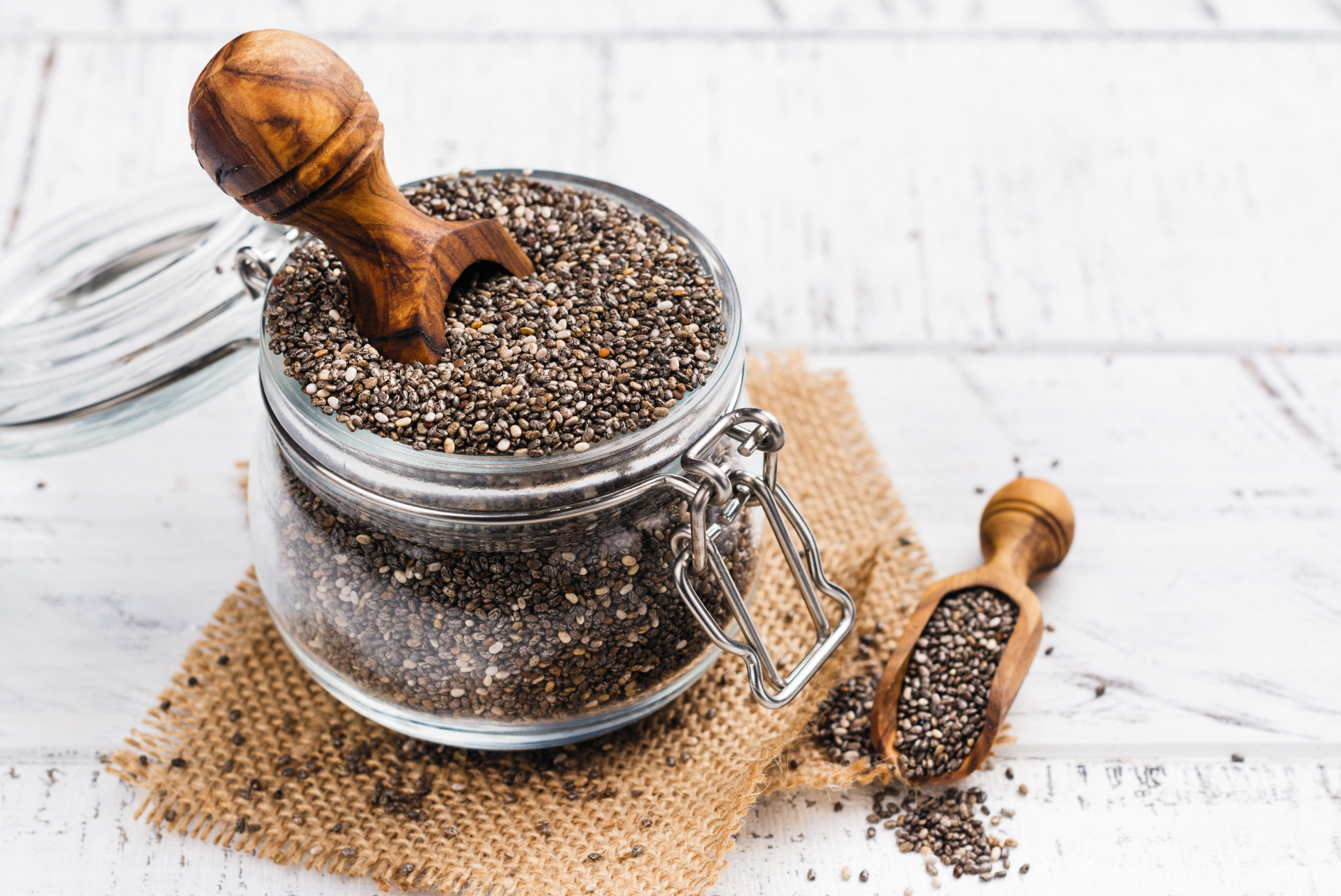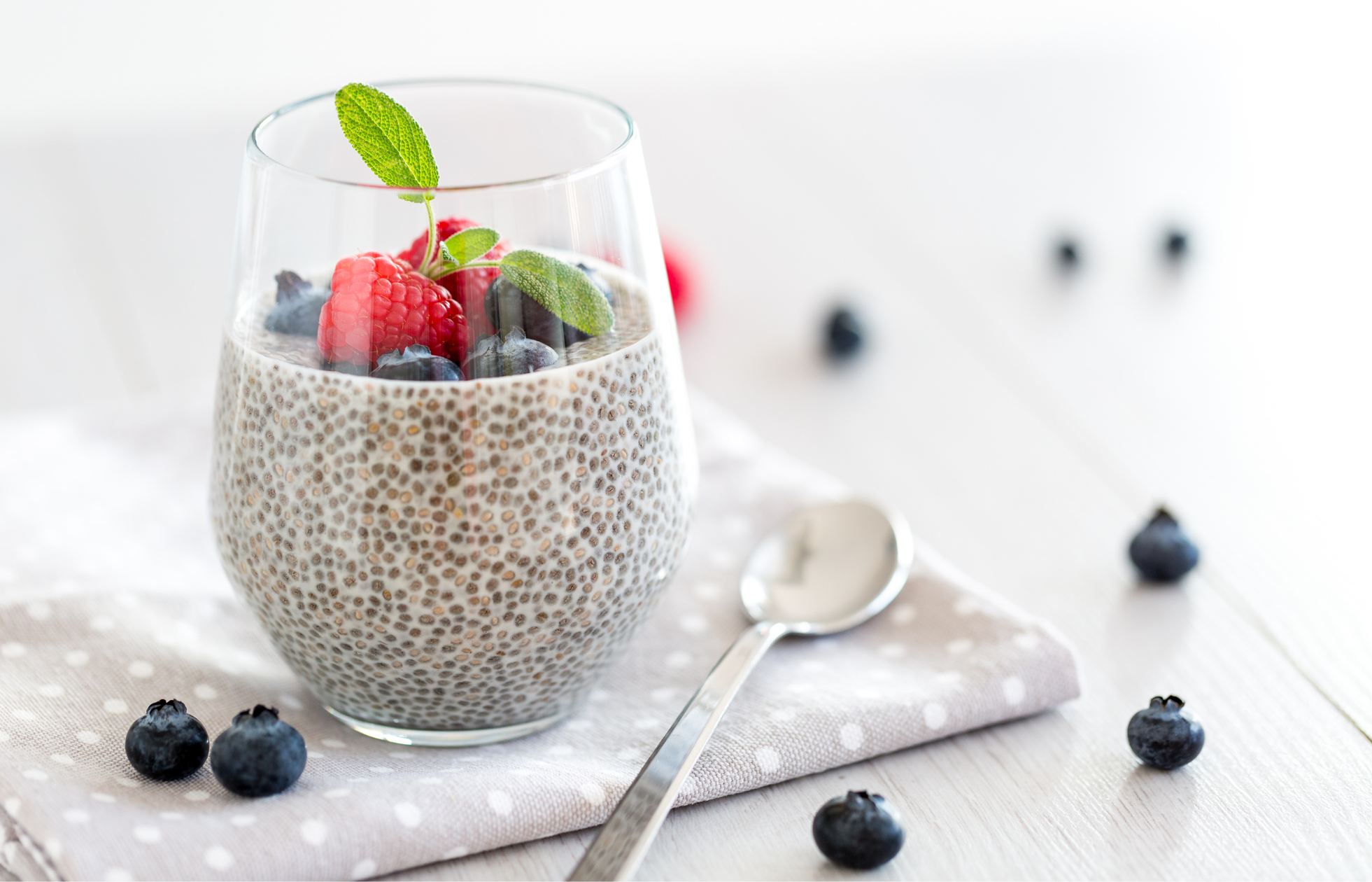Looking for a simple way to boost your health? Consider adding chia seeds to your diet. Chia seeds, have a rich history as a staple food for ancient civilizations like the Mayas and Aztecs in Central America. Today, chia seeds are recognized as a food that can provide many benefits for your body and mind. Let’s explore the rich chemical composition of chia seeds, their various biological activities and effects on the body, and some tips on how to enjoy them.
Tiny but mighty nutrition
Chia seeds are rich in nutrients that are good for your health. The table below compares the nutritional content in ½ cup of dry chia seeds to the Recommended Dietary Allowance (RDA) for people 31 to 70 years old.

Chia seeds are abundant in essential fatty acids, accounting for 80% of their fat composition. They are an important source of omega-3 fatty acids which are required for numerous aspects of human physiology, such as building cellular membranes, providing energy for your body and supporting your heart, blood vessels, lungs, immune system, and endocrine system. Essential fatty acids cannot be made in our bodies and must be obtained from foods like fish, flaxseed, walnuts, and chia seeds.
In addition, chia seeds are high in protein content that provides a complete set of nonessential essential amino acids such as glutamate, the predominant amino acid in chia seeds, which is vital for metabolic activity, nervous system function, hormonal regulation, and cardiovascular protection.
Chia seeds are also an excellent dietary source of insoluble fiber, making up 30-34% of their overall composition. Insoluble fiber is a dietary fiber that does not dissolve in water and benefits health by helping prevent constipation, promoting a feeling of satiety, and supporting the growth of beneficial gut bacteria.
Finally, chia seeds are known for their impressive antioxidant and antimicrobial properties, which can be attributed to the presence of various natural compounds like tocopherols, phytosterols, carotenoids, and polyphenolic compounds, with polyphenols being particularly important for their antioxidant activity. Polyphenols have the ability to minimize the harmful effects of free radicals in the body. Free radicals are unstable atoms or molecules that contain unpaired electrons. Due to this unpaired electron, they are highly reactive and can damage cells, contributing to various health issues. Reducing free radical activity lowers the risk of chronic diseases like type 2 diabetes, Alzheimer’s, and Parkinson’s disease.

Exploring the science: the therapeutic effects of chia seeds
Scientific research has revealed evidence demonstrating the numerous benefits associated with chia seeds. Below are three studies that demonstrate the therapeutic effects of chia seeds in the real world.
Reduces systolic blood pressure in people with type 2 diabetes
One study aimed to determine whether chia seeds can help control blood glucose concentration and lower blood pressure in individuals with type 2 diabetes. Forty-two participants with type 2 diabetes were placed in two groups, either receiving daily doses of 40 g (3 tablespoons) of chia seeds for three months or receiving standard dietary advice. The study measured HbA1c, fasting blood glucose, insulin levels, blood pressure, plasma lipids, body weight, and body mass index (BMI). The results showed no significant differences in HbA1c, fasting blood glucose, insulin levels, body weight, or BMI between the groups. However, the chia seed group demonstrated a significant decrease in systolic blood pressure (SBP) compared to the control group, from an average of 132.5 mmHg at the beginning of the study to 119 mmHg at the end of the 12-week period. In contrast, the control group showed a slight increase in SBP from 123.9 mmHg to 125.9 mmHg over the same period. The reduction of systolic blood pressure by 13.5 mmHg in the chia seed group highlights the potential benefit of chia seeds in managing blood pressure in individuals with type 2 diabetes.
Reduces systolic blood pressure in people with high blood pressure
A second double-blind, placebo-controlled study examined the effects of chia flour supplementation on blood pressure in individuals with mild/stage 1 hypertension. A total of 87 participants were randomly assigned to one of three groups: a group that received chia along with blood pressure medication, a group that received chia with no blood pressure medication, and a placebo group that received blood medication but no chia. For 12 weeks, the groups consumed either 35 grams a day of chia flour or a placebo as instructed. The study measured both clinical blood pressure and 24-hour ambulatory blood pressure. Unlike clinical blood pressure measurements taken at a doctor's office, which provide a snapshot of blood pressure at a specific moment, ambulatory blood pressure monitoring provides a more comprehensive picture of blood pressure patterns throughout the day and night. After 12 weeks, chia supplementation had a significant impact on blood pressure reduction:
- The combined chia groups and the medicated chia group alone showed a significant reduction in mean clinical blood pressure from 111.5 to 102.7 mmHg and from 111.3 to 100.1 mmHg, respectively.
- The non-medicated chia group did not experience a reduction in mean blood pressure, but there was a decrease in systolic blood pressure from 146.8 to 137.3 mmHg.
- The ambulatory systolic blood pressure measurements were reduced in all chia groups, but the mean ambulatory blood pressure was significantly reduced only in the combined chia groups from 98.1 to 92.8 mmHg.
- There were no significant changes in the diastolic blood pressure component in either of the chia groups, and no changes in blood pressure at all were seen in the placebo group.
Improves non-alcoholic fatty liver disease markers
Another study investigated the potential benefits of consuming an isocaloric diet supplemented with chia in improving non-alcoholic fatty liver disease (NAFLD) markers. An isocaloric diet is one in which the total number of calories consumed remains consistent, where the goal is to maintain a balance between the calories consumed and the calories expended without creating a calorie deficit or surplus. This allows researchers to isolate the effects of specific nutrients or dietary interventions on health outcomes while keeping overall energy intake constant. NAFLD is a condition characterized by the accumulation of excess fat in the liver of individuals who consume little or no alcohol and is marked by insulin resistance, abnormal cholesterol, and increased waist circumference. The study included 25 subjects with NAFLD who were instructed to consume 25 g blended chia seeds daily from breakfast through lunch before 6:00 p.m. and to incorporate them into water, salads, or cold dishes. NAFLD markers like BMI, waist circumference, visceral fat, and total cholesterol were measured before and after 8 weeks of chia supplementation. Results showed that chia supplementation reversed NAFLD in 52% of the subjects and was accompanied by decreases in BMI (30.6 to 29.9), waist circumference (100.4 to 97.9 cm), visceral fat (188 to 180 cm2), and total cholesterol (186 mg/dL to 178 mg/dL).

How to eat chia seeds
Chia seeds have a mild, nutty flavor that goes well with many foods and beverages. You can eat them raw or cooked, whole or ground, soaked or dry. Alternatively, you can grind them into a powder to incorporate them seamlessly into recipes. When chia seeds and water are combined, they produce a gel that imitates the texture and function of eggs, which is why they are a popular egg substitute for baking.
Here are some ideas on how to incorporate chia seeds into your diet:
- Sprinkle them on your cereal, yogurt, salad, or toast.
- Add them to your smoothies, juices, soups, sauces, or dressings.
- Make chia pudding by mixing chia seeds with milk or plant-based milk and a sweetener of your choice. Refrigerate for a few hours or overnight until it becomes thick and creamy. You can add fruits, nuts, seeds, or spices for extra flavor and texture.
- Bake them into bread, muffins, cookies, bars, or granola.
- Make chia jam by cooking chia seeds with mashed berries and a sweetener of your choice. Simmer until it reaches your desired consistency, and enjoy on toast, pancakes, or waffles.
- Make chia crackers by mixing chia seeds with water, salt, and seasonings of your choice. Spread the mixture thinly on a baking sheet and bake until crisp. Break into pieces and enjoy with dips, spreads, or cheese.
- Make a chia egg by mixing one tablespoon of chia seeds with three tablespoons of water and let it sit for 15 minutes until it becomes thick and gel-like. Use it in recipes that call for eggs, like pancakes, cookies, muffins, or cakes.
The bottom line
Chia seeds are tiny yet nutrient-packed powerhouses that have gained popularity as a superfood. These small seeds are rich in omega-3 fatty acids, fiber, protein, vitamins, minerals, and antioxidants. They have a mild, nutty flavor and a versatile texture that allows them to be easily incorporated into various dishes. Beyond their culinary uses, chia seeds offer a multitude of health benefits. Chia seeds are a versatile and nutritious ingredient that can help you improve your health, boost your energy, and enjoy your meals.

Sources:
- https://www.tandfonline.com/doi/full/10.1080/23311932.2023.2220516
- https://fdc.nal.usda.gov/fdc-app.html#/food-details/170554/nutrients
- https://nap.nationalacademies.org/
- https://www.sciencedirect.com/science/article/pii/S1756464623000804
- https://ods.od.nih.gov/factsheets/Omega3FattyAcids-Consumer/
- https://newsinhealth.nih.gov/special-issues/eating/rough-up-your-diet
- https://www.mdpi.com/1420-3049/25/1/11
- https://www.ncbi.nlm.nih.gov/pmc/articles/PMC3614697/
- https://journals.sagepub.com/doi/10.1177/0260106020981819
- https://link.springer.com/article/10.1007/s11130-014-0452-7
- https://link.springer.com/article/10.1186/s12944-020-01283-x




